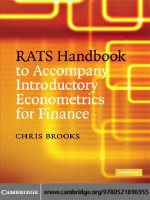0521863589 cambridge university press financial products an introduction using mathematics and excel nov 2008
Bạn đang xem bản rút gọn của tài liệu. Xem và tải ngay bản đầy đủ của tài liệu tại đây (18.74 MB, 407 trang )
This page intentionally left blank
Financial Products
Financial Products provides a step-by-step guide to some of the most important
ideas underpinning financial mathematics. It describes and explains interest rates,
discounting, arbitrage, risk neutral probabilities, forward contracts, futures, bonds,
FRA and swaps. It shows how to construct both elementary and more complex (Libor)
zero curves. Options are described, illustrated and then priced using the Black–Scholes
formula and binomial trees. Finally, there is a chapter describing default probabilities,
credit ratings and credit derivatives (CDS, TRS, CSO and CDO). An important feature
of the book is that it explains this range of concepts and techniques in a way that can be
understood by those with a basic understanding of algebra. Many of the calculations
are illustrated using Excel spreadsheets, as are some of the more complex algebraic
processes. This accessible approach makes it an ideal introduction to financial products
for undergraduates and those studying for professional financial qualifications.
Bill Dalton was Head of the Mathematics Department at Harrow School, 1978–
1998. He retired in 2006 and now writes and lectures part-time in financial
mathematics.
Financial Products
An Introduction Using Mathematics and Excel
Bill Dalton
CAMBRIDGE UNIVERSITY PRESS
Cambridge, New York, Melbourne, Madrid, Cape Town, Singapore, São Paulo
Cambridge University Press
The Edinburgh Building, Cambridge CB2 8RU, UK
Published in the United States of America by Cambridge University Press, New York
www.cambridge.org
Information on this title: www.cambridge.org/9780521863582
© Bill Dalton 2008
This publication is in copyright. Subject to statutory exception and to the
provision of relevant collective licensing agreements, no reproduction of any part
may take place without the written permission of Cambridge University Press.
First published in print format 2008
ISBN-13
978-0-511-43696-3
eBook (EBL)
ISBN-13
978-0-521-86358-2
hardback
ISBN-13
978-0-521-68222-0
paperback
Cambridge University Press has no responsibility for the persistence or accuracy
of urls for external or third-party internet websites referred to in this publication,
and does not guarantee that any content on such websites is, or will remain,
accurate or appropriate.
Contents
Introduction
An introduction to Excel
page 1
9
1
A foundation
34
2
Forward contracts
69
3
The futures market
109
4
Bonds
141
5
The forward rate, forward rate agreements, swaps, caps and floors
185
6
Options
245
7
Option pricing
288
8
Credit derivatives
348
Solutions
Index
375
396
Introduction
This book is an introduction to some of the ways mathematics can be used to
obtain useful, profitable and extremely attractive results in finance. It is now
widely recognised that the financial world has become a profitable hunting
ground for mathematicians. Indeed, without a confident grasp of basic mathematics, many of the most important financial products in the market will not
be understood. It is the aim of this book to explain, in simple terms, some of
the most important ideas of basic financial mathematics. A significant feature
of the book is that Excel spreadsheets are used to assist the reader with the
more tricky algebraic manipulations. If the reader is strong in algebra, the
spreadsheets act as an aid with the calculations. If the reader is not so strong,
these spreadsheets will show, in a numerical framework, what is ‘going on’
in the algebra. By seeing what the spreadsheet is doing, the reader grasps the
purpose of the algebra. An introduction to those parts of Excel used in this
book is given in the first chapter. However, this is not meant to be a tutorial in
Excel; rather, it is a basic covering of those features of Excel the reader will
need. It is important to emphasise that to move ahead with this subject, familiarity and confidence with Excel (or some other programming language) are
essential. Some references are given in ‘An introduction to Excel’.
One of the really attractive features of financial mathematics is that the
subject is so new. The major breakthrough came in 1973 with the classic
Black–Scholes result on the pricing of European call and put options. Almost
everything in this subject has happened since that fairly recent date. This
means that not only are the results new and fresh but so is the thinking
that led to these results. We can still see – very clearly – the problems the
originators were trying to overcome when they produced these wonderful
ideas. Because we are so near the beginning of the subject, there is no long
history to absorb before today’s ideas can be seen. There is no vast theory to
plough through before you can understand today’s problems. In Chapter 8, we
look at recent developments. There are fewer exercises attached to this chapter.
In a sense, the problems that could be attached to Chapter 8 are close to what
2
Financial Products
mathematicians are working on today. In this subject, it is not a long bus ride
to the frontier.
So who is the book for?
1. Level of mathematical ability:
We have aimed the book at:
◦ very good GCSE candidates, who are confident enough to try new things
in mathematics
◦ those who have at least some AS Mathematics experience: ideally in the
C1 and C2 pure modules and in the S1 statistics module.
2. Courses, examinations involving the subject matter of the book:
◦ Business Studies, Finance, Investment and Economics courses in institutions of higher education and universities.
◦ The Securities and Investment Institute: Certificate in Investment Administration; Certificate in Investments; also, the Financial Derivatives
Module.
◦ The Faculty of Actuaries and Institute of Actuaries Finance and Investment, Specialist Technical B syllabus: Certificate in Derivatives.
◦ The CFA Program (Chartered Financial Analyst): Analysis of Debt Investments (VII); Analysis of Derivatives (VIII).
What is the book about?
There are eight chapters.
Chapter 1 describes the building blocks of the subject. We describe interest
rates, how they are calculated and how they may be used. Then interest rates
are used to describe the present value (or the discounted value) of money. We
define and explain the important idea of arbitrage, after which we illustrate
risk neutral probabilities. Finally, we take a first look at a curve illustrating the
development of interest rates: the zero curve.
Chapter 2 implements some of these ideas and describes in full detail how
forward contracts operate and change in value as time passes.
Chapter 3 takes forward contracts into the market place and provides a full
description of futures contracts. We describe the mechanics of futures contracts and illustrate how they might be traded. We show how futures contracts
can be used for speculation and for hedging risk.
3
Introduction
Chapter 4 looks at bonds: what they are and how they are priced. We look at
quotations, day count conventions, bond yields and how to compare different
bonds. We show how futures contracts and bonds can be used together and,
finally, we make a second attempt to construct a zero curve.
Chapter 5 takes forward the idea of interest rates – literally – and considers
interest rates over future time periods. We look at forward rate agreements
and show how to achieve, over a future time period, an interest rate that
is fixed today. We define and describe interest rate swaps and the swap rate
and illustrate some applications of swaps. We describe and illustrate caps and
floors. We show how to enter a futures contract on an interest rate and, finally,
we construct and plot a realistic zero curve.
Chapter 6 takes a pictorial look at options. We describe many options
(including call and put options) with their pay-offs and the strategies determining their use. We illustrate put–call parity. We show how the options can
be used to hedge risk and for racheting up profits.
Chapter 7 shows how options can be priced. We describe in elegant detail
a binomial tree method for pricing European and American options. We
describe and illustrate the Black–Scholes formula.
Chapter 8 points to the future. In this chapter, we remove the idea that all
debts will be honoured in full on the day they fall due and see what happens.
We consider, from two different standpoints, the probability that a company
will default on its obligations and look at an outstanding problem in this area.
Finally, we describe four ways in which, for a price, risk can be considerably
reduced, if not eliminated.
What further help is available?
There are internet sites. We give below some that the author has found helpful,
but as can be imagined, in this rapidly developing field where communication
is all important, there are many, many more.
Educational (helpful with definitions, explanations and background
material):
www.defaultrisk.com
Mainly credit risk and credit
derivatives
www.investopedia.com
www.investorguide.com
www.investorwords.com
4
Financial Products
www.riskglossary.com
en.wikipedia.org
Information and data:
www.moneyextra.com
www.moneyfacts.co.uk
yahoo finance
Exchanges and markets:
www.bankofengland.co.uk
www.cbot.com
www.cme.com
www.ftse.com
www.liffe.com
www.londonstockexchange.com
An excellent and really useful site
offering both information and
large amounts of data.
Bank of England
Chicago Board of Trade
Chicago Mercantile Exchange
FTSE International
London International Financial
Futures and Options Exchange
London Stock Exchange
Newspapers and news (also helpful with data and background information):
www.bbc.co.uk
BBC
www.bloomberg.com
Bloomberg
www.ft.com
Financial Times
www.reuters.com
Reuters
money.cnn.com
CNN and Fortune magazine
yahoo finance
Helpful here, also
And there are books. Again, the choice is large, but again, the list below
contains those the author has found particularly helpful.
r Baxter, Martin and Rennie, Andrew, Financial Calculus: Cambridge
University Press
A joy. The book starts from basics and moves apparently seamlessly
through binomial trees to continuous models to an interesting presentation
of interest rate models. This book is both profound and hugely enjoyable.
r Benth, Fred Espen, Theory with Stochastic Analysis. An Introduction to
Mathematical Finance: Springer
A good, approachable introduction to the next stage in the subject; deals
with stochastic integration and martingales. Shows some VBA programs
(Monte Carlo simulation and numerical methods).
5
Introduction
r Choudhry, Moorad, An Introduction to Credit Derivatives: Elsevier
r
r
r
r
r
r
r
r
r
(Butterworth-Heinemann)
A straightforward introduction to credit derivatives. Case studies, diagrams and pictures of computer screens are helpful.
Etheridge, Alison, A Course in Financial Calculus: Cambridge University
Press
Mathematically much more advanced, but very readable in the introductory sections. For anyone wanting to take the subject further and develop
the more mathematical approach, this is a terrific book. (See Benth’s book
as a possible introduction.)
Hull,JohnC.,Options,FuturesandOtherDerivatives:PrenticeHall(Pearson Education International)
Described by many as ‘The Bible’ of the subject. A first-class book for
beginners and experienced practitioners alike.
Luenberger, David G., Investment Science: Oxford University Press
A very good and broad introduction to the subject.
Meissner, Gunter, Credit derivatives: Blackwell Publishing
Credit derivatives in a discrete setting.
Neftci, Salih N., An Introduction to the Mathematics of Financial Derivatives: Academic Press
An excellent introduction to the subject and to the harder mathematics
that will follow if the reader wishes to take the subject further.
Sch¨onbucher, Philipp J., Credit Derivatives Pricing Models: John Wiley
Very good indeed. The early part of the book is more descriptive, with
concrete examples; later sections involve more advanced mathematical ideas.
The book focuses mainly on credit risk and credit derivatives (Chapter 8).
Servigny, Arnaud de and Renault, Olivier, Measuring and Managing
Credit Risk: McGraw-Hill
Very readable, vast in scope, mainly concerned with credit risk and credit
derivatives (Chapter 8).
Shreve, Steven E., Stochastic Calculus for Finance I and II: Springer
Volume I focuses on the binomial tree method. Volume II considers continuous models. Very readable, interesting and beautifully presented. Volume I
complements and extends Chapter 7.
van der Hoek, John and Elliott, Robert J., Binomial Models in Finance:
Springer
A very clear description of how binomial trees can be used in more
advanced modelling. Topics include assets paying dividends, exchange rate
6
Financial Products
contracts and interest rate derivatives. The authors show how binomial
tree models can be constructed to calculate values consistent with market
prices.
r Wilmott, Paul, Derivatives: The Theory and Practice of Financial
Engineering: John Wiley
A first-class introduction to the subject; very well organised and extremely
readable. The Excel diagrams make reader participation almost a certainty.
r Wilmott, Paul, Howison, Sam and Dewynne, Jeff, The Mathematics of
Financial Derivatives: Cambridge University Press
Although mathematically more advanced, the book is genuinely an ‘introduction’ to the subject. Very clear and readable. Probably the best introduction to the subject using the differential equation approach.
For Excel:
Advanced Modelling in Finance using Excel and VBA, Mary Jackson and
Mike Staunton: Wiley Finance – an excellent book and really useful for
performing calculations in Excel. Includes VBA programming.
Excel 2000/2003 VBA Programmer’s Reference, John Green: Wrox – for
serious programmers.
Excel 2003, Steve Johnson: Pearson, Prentice Hall
Excel 2003 in Easy Steps, Stephen Copestake: Computer Step
Maran Illustrated Excel 2003: Maran
Microsoft Office, Excel 2003 Quick Steps, John Cronan: McGraw-Hill
Visual Basic 2005 Demystified, Jeff Kent: McGraw-Hill
Assumptions
We assume (almost) throughout the book that the price an asset can be bought
for is the same as the price the asset can be sold for. This gives the asset ‘one
price’ which is convenient for pricing theory.
We assume no transaction costs. So when a commodity is bought or sold,
there is no charge made by the agent handling the sale. Again, this is not wholly
realistic, but this assumption does make it easier to see what is happening in
the theory without becoming embroiled in administration.
We assume no costs of storage. This applies mainly in Chapter 2 with forward
contracts on commodities.
Short selling is a way to derive profit from a fall in the value of a share or
some other security. A ‘short seller’ will borrow a security and immediately
7
Introduction
sell it. The short seller hopes the security will then fall in value. If this happens,
the short seller will buy the security (at a lower price) and replace what he has
borrowed. The difference in prices becomes the short seller’s profit.
If this sounds easy, there are strict regulations governing ‘short sales’. Two
of the non-legal regulations are that any dividends that are paid during the
period in which the security has been borrowed must be paid to the rightful
owner by the short seller, and if the security is required by the rightful owner,
the short seller has to replace the security immediately. There are also dangerous overtones in short selling. There is the potential for unlimited loss. If
the security rises in value, the short seller must purchase at the higher price
(perhaps the considerably higher price) to replace the security.
We certainly are not advocating that the reader becomes involved in short
sales. This is completely a game for the professionals. But we do use the idea
of short selling in some of the pricing arguments.
Names of companies, firms and organisations
These are almost entirely fictitious. We have used the names BT and BP: all
other names bear no resemblance to any organisation existing now or in the
past. The reason for this is that, of course, the share price and the financial
standing of a company change over time. So what might be a realistic share
price today will almost certainly not be realistic by the time this is being read.
Using real companies would mean that with high probability, the data would
be inaccurate and possibly misleading. There are no such problems with a
fictitious company.
To the reader
But what really matters is that the reader has the enthusiasm and determination
to try out the examples and exercises for themselves. Put pen to paper. Try
to see what is actually happening. Financial mathematics is not a spectator
sport. You need to get involved. And involvement means doing. If the algebra
is looking taxing, there are Excel spreadsheets to help you through the worst
of it. We hope you enjoy the ideas that lie ahead. This is a beautiful subject:
it is important and potentially highly profitable. It is hard to think of more
compelling reasons to read a book.
8
Financial Products
Acknowledgements
With grateful thanks to Gary Cook for his invaluable advice in matters of Excel.
To Ian Hammond, who, with his many friendly enquiries – ‘How’s the book
going?’ – shamed me into writing, when I would have preferred to be doing
other things. To the referee for his/her many helpful, perceptive, well-informed
and extremely useful observations. I am grateful to David Buik and Andrew
Garrood of Cantor Index for very helpful initial discussions on the content of
the book. To the editorial and production staff of Cambridge University Press
for all their considerable expertise and their unfailingly helpful and patient
advice. To Mike and Tim for listening, being occasionally impressed but always
totally supportive. And to Dorothy, for her help with writing and editing, for
being calming and encouraging and for providing a reassuringly normal and
happy world when the writing was going badly. To all, I offer heartfelt thanks.
Theirs was the inspiration. The mistakes, alas, are all mine.
An introduction to Excel
All the calculations in this book can be performed on a calculator. However,
they can be performed more efficiently and much faster on a spreadsheet in
Excel. If a calculation has to be repeated, then with a spreadsheet in place the
repeat calculation is almost immediate. With a calculator, you just have to start
again.
In this chapter we present a short introduction to those features of Excel that
are used to perform calculations in this book. We recommend, however, that
the reader acquires a complete introduction to Excel and learns more about
this remarkable facility. To go further with financial mathematics, a knowledge
of VBA (Visual Basic for Applications and available through Excel) or some
other high-level programming language is essential. (See the texts described
in the Introduction.)
The starting point for an Excel calculation is an Excel worksheet (Figure 1).
We have indicated the menu bar, the tool bars and the formula bar. Also, for
future reference, we have indicated the chart wizard, the paste function and
the name box.
Each cell in a worksheet has a name or a reference. This is letter followed by
number. In Figure 1, the cell B6 is illustrated. Observe that the letter identifies
the column (B) and the number identifies the row (6).
To enter a number, words or a formula in a particular cell, left click the
required cell. The heavy border indicates that this is now the active cell. (The
cell has been ‘highlighted’).
For a number or words:
type in the number or the words
press Enter
For a formula:
type = followed by the formula
The formula bar now has the symbols shown in Figure 2.
To enter the formula, click the Enter button. Or, press Enter. To cancel,
click the cross.
Figure 1
Name box
Active cell
Paste function
Menu bar
Chart wizard
Formula bar
Figure 2
12
Financial Products
Exercise
Enter ‘asset value’ in cell A5
(enter words)
Enter 10.3 in cell A6
(enter a number)
Enter 8.1 in cell A7
Now enter a formula to add these two numbers and store the sum in A8.
Click A8: type = A6 + A7: click the Enter button or press Enter.
The result should be as in Figure 3.
Note: from now on, to enter a formula we will write only ‘press Enter’. But
the option to click the Enter button is always there.
The way ahead
Excel has an easy way of entering expressions (e.g. 3x2 − 4x + 1) and then
calculating the value of the expression for as many values of the underlying
variable as are needed. We will illustrate the important techniques involving
‘creating formulas’, ‘dragging down’ and ‘graph drawing’ by calculating the
value of 3x2 − 4x + 1 for x values x = −5, −4.5, −4, . . . 4.5, 5 and then
drawing the graph y = 3x2 − 4x + 1 for x values −5 ≤ x ≤ 5. We then
show this can be achieved more conveniently by using ‘absolute cell referencing’ and ‘range names’. Then we point to the vast number of functions
available in Excel. Finally, we will illustrate ‘Goal Seek’ by solving the equation
5e2R+1 = 37.
(a) Creating formulas
We want to calculate the value of 3x2 − 4x + 1 for x = −5, x = −4.5,
x = −4, . . . x = 4.5, x = 5.
(i) Select the cell that is to contain the x value. Let this be D3.
Click D3. Enter −5. Press Enter.
(ii) Select the cell that is to contain the formula. Let this be E3.
Click E3: type = 3∗ D3∗ D3 − 4∗ D3 + 1: press Enter.
In E3, we have 3x2 − 4x + 1 evaluated at x = −5. (= 96)
This is good, but we can do much better.
(b) Drag down (evaluating formula in a range of cells and highlighting)
Click D4: type = D3 + 0.5: press Enter.
(We have entered a formula to add 0.5 to the number in the cell immediately
above. You will see −4.5 appear in D4.)
Figure 3
14
Financial Products
See a small black square in the bottom right-hand corner of the heavy border.
This is called the drag handle.
Click on the drag handle and holding down the mouse button, drag down
column D19 cells (to D23).
Release the mouse button.
You will see Figure 4.
These are the ‘x values’.
We repeat the drag down procedure with E3.
Click E3.
See the drag handle in the bottom right-hand corner of the heavy border.
Click on the drag handle and holding down the mouse button, drag down
column E twenty cells (to E23).
Release the mouse button.
You will see Figure 5.
In E3:E23 we see the result of evaluating 3x2 − 4x + 1 at the different x
values shown in column D.
Click E10. In the formula bar, you will see 3∗ D10∗ D10 − 4∗ D10 + 1, which
is our formula evaluated at D10.
The words ‘drag down’ are used also in highlighting. When a cell is clicked,
the cell becomes shaded and we say the cell has been ‘highlighted’. If a range
of cells is to be highlighted, click the top cell and without releasing the mouse
button, drag down to the bottom cell in the range. Release the mouse button.
You will see that the range of cells has been ‘highlighted’.
Note that when a calculation is being ‘dragged down’ through a range of
cells, it is the drag handle that is clicked before the mouse drags the calculation
through the cells. When a range of cells is being highlighted, the top cell in the
range is clicked before the mouse is dragged to the bottom cell in the range.
(c) Graph drawing
Click D3. Hold down the mouse button and drag down to D23. Release the
mouse button. You will see D3:D23 highlighted.
Press CTRL and keep this button depressed. Click E3. Drag down to E23.
This will highlight E3:E23 (now you will see both columns highlighted).
Release the mouse button and CTRL.
Click ‘Chart Wizard’ on tool bar (see Figure 1).
You will see Figure 6.
Click ‘XY (scatter)’. Click the highlighted graph (as shown).
Click Next.
Figure 4
Figure 5
Figure 6









